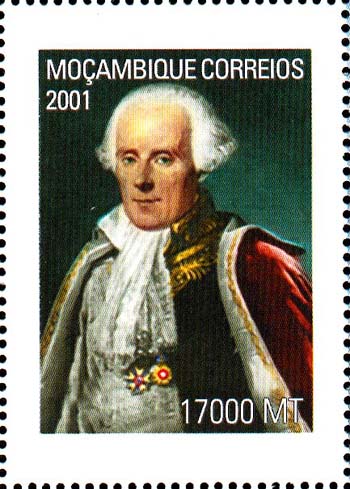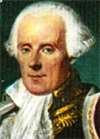Pierre-Simon Laplace
Laplace was born to prosperperous farming family in France. Other than an uncle who apparently taught high school mathematics, there were no indications from his family history that he would become one of the greatest scientists of all time.
Typically persons of his rank would have sought careers in either the military or the clergy, and indeed Laplace initially studied theology. However, by age 19 he knew mathematics was to be his career and arrived in Paris with a letter of introduction to d'Alambert. Almost immediately he presented papers to the Académie des Sciences and by age 22 made a bid to be elected to the Académie. Indeed, he was offended that he was passed over, an indication of the high esteem in which he held his own abilities. The fact that his view of his abilities was justified could not have helped his political position. In 1773 Laplace was elected to the Académie and throughout the next ten years published some of his best work. He was never modest about his achievements and seemed insenstive to the impact this had on his colleagues.
In 1784 Laplace was made an examiner of the Royal Artillery Corps, a post which brought him to the attention of those with political influence. Among others, he examined a young 16-year-old cadet named Napoleon Bonaparte in 1785.
After the Revolution, Laplace was named a member of the committee to reform weights and measures. However, he was thrown off the commission during the Reign of Terror in 1783 and fled Paris. This possibly saved his life -- his friend and collaborator Lavoisier, with whom he had studied human respiration and proved it to be a form of combustion, was guillotined at this time.
Returning to Paris in 1794, Laplace regained political favor and over the years was named to many administrative posts. During these years he wrote fundamental books such as Exposition du systeme du monde and Traité de Mécanique Céleste solidifying his reputaion as a scientist and mathematician.
Under Napolean Laplace was a member, then Chancellor, of the Senate. While Napolean removed him as Minister of the Interior for "bringing the spirit of the infinitely small to government," Laplace was named a Count of the Empire in 1806.
In 1812 Laplace published the first edition of Théorie Analytique des Probabilités. The first edition was dedicated to "Napolean-le-Grand" -- a dedication that was removed from later editions! This book and its later editions studies generating functions and various approximations needed in probability, introduces what is today known as Baye's Rule (so mis-named by Poincare). The book also includes applications to "moral" statistics (what we today would call social statistics), mortality, life expectancy and legal matters.
Throughout most of his life Laplace changed his political views according the events of the day. This chimerical approach served him well early on, but many of his colleagues regarded him as self-serving and opportunistic. Thus when he mis-judged the political climate, as with his support of the Bourbon restoration in 1814, there were many enemies ready to take advantage. When he failed to support the Academy's position of freedom of the press in 1826 he lost all political influence.
Today Laplace is recognized as one of the greatest mathematicians and scientists of all time. His contributions to physics, probability, mechanics and many other areas place him in the first rank of scholars. His image has been on many stamps issued by many countries, such as the 2001 stamp below issued by Mozambique.

Born: 23 March 1749 in Beaumont-en-Auge, Normandy, France
Died: 5 March 1827 in Paris, France
The premiere site for biographies of mathematicians on the web is at The University of Saint Andrews in Scotland; this is the primary source of the information in these short biographies. Some biographies used additional web resources as noted in the biography.
The postage stamp images came from a wonderful site on mathematicians on stamps maintained by Jeff Miller, a mathematics teacher in Florida.
The Free Internet Encyclopedia Wikipedia is also an excellent source of information and was used as a reference for many bographies.
The opinions expressed in these biographies are those of the author and do not reflect official views of the University of Oklahoma.
